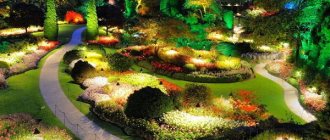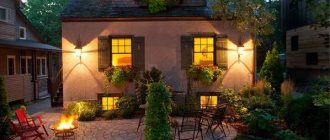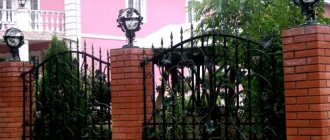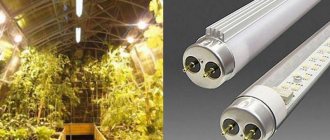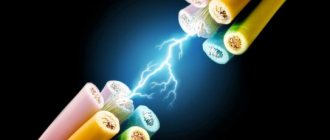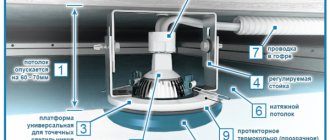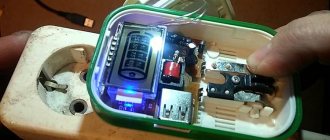Why do we need additional lighting in greenhouses?
The future harvest, its integrity and the turnover of these products depend on this indicator. Currently, in almost any hardware store, you can find several options for additional lighting for a greenhouse.
Lighting in a greenhouse is also necessary for photographing plant crops. Currently, a very popular driver for selling products is the distribution of photos or videos of the growth of plant products, and it is quite clear that high-quality materials cannot be made without good lighting in the greenhouse.
Nuances of greenhouse lighting
When choosing and arranging lighting in a greenhouse, you also need to take into account the factor of periods that change daily or annually. This will allow you to build an effective plant growing system.
in winter
With the onset of cold weather, the length of daylight hours decreases, which reduces the intensity of radiation from the natural source. At this time, the greenhouse is illuminated with lamps, practically ignoring the sun's rays; for crops in a winter greenhouse, the day length is calculated to be at least 12 hours. This is especially true when growing cucumbers, nightshades, peppers and pumpkins. But for tomatoes, carrots, beets and others, the duration of lighting should be increased to 13 - 14 hours.
At night
If you supplement daylight, lamps can be used effectively at night. Such lighting is turned on in cloudy weather, when the plants did not receive enough light during the day, or when there is a technical need to take a break from the operation of the equipment. In the case of daily night lighting, the process can be automated by using timers or time relays.
What devices and lamps are needed for lighting?
When arranging a greenhouse, the first thing installed in it is lamps for lighting. This is explained by the fact that in winter there is a shortened daylight hours and it is simply not enough for plant development.
There are several types of such lamps:
- for overhead lighting;
- lateral spread of light;
- combined type.
Plants' need for sunlight
It is known that daylight white light consists of waves of different lengths, which together make up the visible spectrum. It is limited to wavelengths from 380 nm (violet) to 780 (red).
Plants are most susceptible to the blue, orange and red ranges of the light spectrum; when exposed to waves of this length, photosynthesis processes occur most intensively. Perception peaks are 445 nm and 660 nm. Plants practically do not absorb the green and yellow parts of the spectrum. This is what explains the color of the leaves - green waves are reflected from the plants.
At the same time, at different phases of development, plants require different lighting. Thus, during the initial active growth and accumulation of green mass, the blue component of the spectrum is more useful, and in the flowering and fruiting phase, the red component is more useful.
For plant illumination to be effective, it is necessary to create a light spectrum close to daylight, or even better, to enhance the red and blue parts of the spectrum and, to save money, eliminate the useless yellow-green component.
An equally important parameter is the luminous flux in a given spectrum from 400 to 700 nm, or an indicator of photosynthetic active radiation . In the characteristics of lamps, it is denoted by the abbreviation PAR and is measured in micromoles per square meter per second - µmol/m 2 ·s.
The need of different plants for photosynthetic active radiation is different; examples are shown in the figure. If the value is lower, the plant will grow and develop poorly; if it is exceeded, burns may appear on the leaves.
the ratio of light power to consumed power, is sometimes used . The higher this indicator, the more economical the use of the lamp and the lower the energy costs.
The optimal luminaire for lighting a greenhouse should produce light in the desired spectrum with a sufficient PAR value, while being able to adjust the spectrum depending on the growth phase of the crop. LED phytolamps and lamps meet these requirements; they are more reliable and more economical than other types of lamps.
Prices for phytolamps
How does plant growth depend on light?
Due to the influence of this type of lighting, plants can be divided into the following categories:
- plants with shortened daylight hours;
- plants with long daylight hours;
- plants that do not have specific requirements for daylight hours.
Main conclusions
LED lighting devices are optimal as lighting for growing plants in greenhouses. They are economical, do not heat up, are durable and moisture resistant. In addition, agricultural models produce only useful blue and red radiation and exclude other wavelengths. Based on their external design and design, they are divided into the following types:
- Separate - lamps, diodes.
- Tubes
- Spotlights.
- Square.
- Stripes.
The main advantages of LED lighting for greenhouses come down to energy savings, richness and stability of lighting parameters, durability, high efficiency, harmlessness, ease of installation and ease of maintenance. When calculating their power, you need to take into account the placement height, power, lighting requirements for the plant and the area of the room. At the same time, the most common types of lamps used in such conditions are lamps, strips and spotlights.
If you have experience using LED lighting devices in your greenhouses, be sure to share such useful information in the comments.
Source
How to choose lighting for a greenhouse?
In order to organize a sufficient level of light for all plants, it is necessary to perform the following work:
- install lighting fixtures so that they are located above the first leaf of the plants;
- select the necessary lamps corresponding to the power;
- when purchasing lamps, you should select the necessary lighting device for each plant;
- when calculating the required number of lamps and spotlights, the area of the greenhouse is taken into account;
- special attention should be paid to what season of the year and time of day lighting is required;
- all lighting devices must be located at a certain distance and have a light source that is suitable for each plant;
- In order to increase the luminous flux and save energy, mirror, foil and aluminum reflectors are installed in greenhouses.
But the most important process in selecting lighting is the correct choice of light parameters.
In order to create optimal lighting for growing greenhouses, it is necessary to take into account that short daylight hours and weak electric lighting will reduce the growth of seedlings.
And in the future they will affect the fruiting of all cultivated plants, so you need to follow a number of rules:
LED lamps - which are better? Review of the most popular and reliable models, with photos and videos!How to choose a color temperature - see here! Table, instructions, overview of bright and optimal color temperature for the room
Connecting a lamp with your own hands - step-by-step instructions with photos and videos. Installation rules + connection diagram
- additional lighting must be installed before the first shoots appear;
- in the illumination of greenhouses there should be no sharp transition or intervals of dim light, that is, after daylight, artificial lighting should gradually turn on;
- during seedling growth, its daylight hours should be extended to 12 hours;
- It is worth considering that for normal growth of seedlings, you need to observe 6 hours of darkness; if this is not done, the plant will drop its flowers;
- During seedling growth, a blue spectrum of light is required, and during flowering, red light of a certain power is required.
Supplementary lighting in greenhouses
This article continues the topic raised in the article “LED light for greenhouses” (published on the resources www.enova-l.ru and rusteplica.ru). Aspects of modern greenhouse supplementary lighting are covered.
WHAT NATURE GAVE
The main and most important property of plants is photosynthesis. The essence of photosynthesis is that plants use sunlight to convert water and carbon dioxide into oxygen and sugars (organics). Those. convert solar energy into chemical energy. This property is used by humans when growing various plant crops.
Of course, the most favorable type of lighting for plants is natural lighting, characteristic of the habitats of a particular crop in question. Evolution has done and is doing its job.
The only source of natural light is the sun. It emits light, some of which is scattered in the atmosphere and creates diffuse radiation. Those. One should distinguish between light falling directly from the sun and light from the “sky” - sunlight scattered by the atmosphere. In the shadow, the properties of light also change due to partial and selective reflection or absorption of various spectral components. Natural light varies depending on the time of day, atmospheric conditions, weather conditions and time of year. The main feature of natural lighting is the variability of the intensity and spectral composition of its radiation, which is influenced by natural and random factors.
The nature of light is corpuscular-wave in nature. That is, light has both the properties of a particle and an electromagnetic wave. A particle of light, a photon, can have a different frequency of an electromagnetic wave ѵ, the magnitude of which determines the energy of the photon E:
Е=hѵ, where h = 6.63×10-34 J×sec – Planck’s constant.
Typically, light sources emit photons of different frequencies, which together form the emission spectrum of a given light source. For convenience, when considering the spectrum of visible light, we operate not with the frequency of the photon, but with its wavelength. In this case, the wavelength is measured in nanometers. The range of photosynthetic active radiation (PAR - radiation that is absorbed by plants during photosynthesis) approximately coincides with the range of the visible part of light. “Blue” photons have a shorter wavelength compared to “red” ones. Those. have a higher frequency and more energy. The energy difference at the boundaries of the phased array is almost twofold.
WHAT SCIENCE SAYS
Research in the field of photosynthesis is based on the works of K. A. Timiryazev and on the theory of the photoelectric effect formulated by A. Einstein. According to these ideas, it was believed that the intensity of photosynthesis depends not on the amount of energy absorbed, but on the number of absorbed photons. As a result, it was concluded that the absorbed energy in the red part of the spectrum is used more efficiently, since the energy of “red” photons is much less compared to “blue” ones. That is why the system for assessing greenhouse light, based on measuring the photosynthetic photon flux (PPF), has gained popularity abroad, i.e. the number of photons emitted by a light source per unit time in that part of the spectrum that is suitable for photosynthesis (400-700 nanometers (according to some estimates 320-750 nanometers)). In practice, the FPP level is measured in µmol/sec (1 mol = 6.023x1023). Equipment for accurately measuring FPP has been and remains quite expensive for general use. In the USSR, and then in Russia, such assessment methods as measurement in lux and measurement of the level of photosynthetic active radiation (PAR), expressed in watts, were widely used. Measurement in lux is not correct, since this unit of measurement is focused on the characteristics of human vision and is not suitable for an objective assessment of greenhouse light sources*. From the point of view of the concepts described above, measurements of the FPP or PAR did not provide a complete picture of the efficiency of the light source, since they did not reflect the qualitative composition of the emission spectrum of this source.
In 2014, evidence was obtained that the mechanism of photosynthesis uses vibronic quantum coherence [3]. The essence of this phenomenon is that the energy of absorbed photons is used by the plant with a very high efficiency close to 100%. This means that the energy of any photon (“blue” or “red”) is fully used without loss. This in turn means that the intensity of photosynthesis still depends not so much on the number of absorbed photons, but on the amount of energy absorbed. This sounds reasonable, since it is difficult to suspect nature of its inability to effectively use available resources. Modern research indicates that plants use a complex molecular complex to capture light. Chlorophyll molecules and other light-absorbing antenna pigments are capable of capturing photons of various wavelengths from the entire PAR range. A special group should include “green” photons, which are practically not absorbed due to almost complete reflection from the surface of the sheet.
It turns out that it is more correct to measure the PAR level in watts, rather than the PAR level in µmol/sec. And the quality of the spectrum is assessed by the degree of similarity to natural light. In any case, for full growth of plants, blue and red spectral components are needed. Both theorists and practitioners will agree with this. The plant photosynthesis system has great flexibility in adapting to environmental conditions, including the spectral composition of the spectrum. But such adaptation occurs due to changes in the biochemical structure. And if you try to greatly change the natural growing conditions of a crop, you may get a result that you did not expect. For example, “plastic” tomatoes or cucumbers without taste or smell. This result may be partly due to the use of high-pressure sodium lamps (HPS).
Carrying out PAR measurements in watts is not only more convenient, but also cheaper. The price of such a device is comparable to the price of a lux meter. For LED lamps, it is quite simple to carry out a theoretical calculation of the level of useful radiation in watts, since all LED radiation falls entirely in the phased array region (400-700 nanometers). The same cannot be said about NLVD and other types of greenhouse light sources.
We will demonstrate the simplicity of the theoretical calculation using the example of the white LED LH934A from SAMSUNG. The manufacturer provides this LED with data on the dependence of dissipated (thermal) power on power consumption (see Figure 1). The emission power of the LED in the phased array region is calculated as the difference between the power consumption and the dissipated power. Thus, by choosing the operating mode of the LED by fixing the power consumption, the developer is able to calculate the emission power. This is very important, since the consumer can independently evaluate the capabilities of a particular LED lamp.
Figure 1. Dependence of power dissipation on power consumption.
White LED has a continuous spectrum, like natural sunlight. Its qualitative composition is closest to solar radiation compared to other greenhouse light sources. For an LED with a color temperature of 5000K, the spectrum is shown in Figure 2.
Phytolights that use red and blue LEDs have a discrete spectrum composition (see Figure 3). It is easy to notice that the spectrum of such phytolights, unlike NLVD (see Figure 4), has a high level of “blue” spectral components (the proportions of “blue” and “red” components can, in principle, be adjusted). This is an absolute plus. But this spectrum is still very different from the solar spectrum. How such a difference can affect the quality of plant growth is a question that requires additional research.
Figure 2. Spectrum of a white LED with color temperatures of 4000K and 5000K.
Figure 3. Spectrum of phytolights with color LEDs.
Figure 4. Spectrum of NLVD DNase Reflex.
*Typical example. White LED models are available in a wide range of color temperatures from 2000K to 7000K. The PAR power for all color temperature options for a specific white LED model will be unchanged. While the level of luminous flux will be different.
DAYLIGHT
Regular factors influencing the variability of natural light are the height of the sun above the horizon and geographic latitude. Random factors include the state of the atmosphere (clear, rain, fog, etc.) and the effects of reflection and absorption of light from the ground and surrounding objects.
Figure 5. Spectral characteristics of natural light.
As the sun rises, the light intensity and color temperature increase. Short-wavelength rays of light (violet to green) are refracted more strongly in the Earth's atmosphere than long-wavelength rays (yellow and red). Therefore, the first and last rays of the sun are blue and green. Gas molecules and aerosols are responsible for most of the absorption of radiation. The scattering of solar radiation on water droplets and ice crystals occurs over the entire spectral range. Molecules mainly scatter radiation of short wavelengths, and aerosols scatter longer ones. This leads to an increase in the proportion of short-wave components (and, accordingly, to an increase in color temperature) as the sun moves towards its zenith.
The density of clouds, their height and location in relation to the sun, haze, fog, rain, snow have a significant impact on the illumination of objects, contrast and spectral characteristics of light. For example, in the presence of cumulus clouds, the illumination of unshaded objects illuminated by the sun increases by 25%, and the illumination in the shadow increases by two and a half times. The contrast of lighting is reduced by approximately two times compared to lighting in cloudless weather. When there is continuous cloudiness, a significant decrease in illumination and lighting contrast is observed.
Table 1. Spectral characteristics of natural light.
| Daylight phases | Color temperature of radiation, K |
| Direct sunlight at sunrise and sunset | 2200 |
| Direct sunlight one hour after sunrise | 3500 |
| Direct sunlight early morning and late afternoon | 4000…4300 |
| Sunlight at noon in summer | 5400…5800 |
| Diffused daylight in the shade in summer | 7000 |
| Diffused daylight in cloudy weather | 7500…8400 |
| Light from the blue sky | 9500…30000 |
| Data are given for the middle band (latitude 550) | |
Table 2. Example of illumination of the earth's surface in cloudless weather at different periods of the year and hours of the day, %.
| Months | Time of day, hour | ||||||||
| 5 | 7 | 9 | 11 | 13 | 15 | 17 | 19 | 21 | |
| June | 1 | 3 | 6 | 89 | 100 | 89 | 58 | 24 | 1 |
| May – July | 1 | 19 | 54 | 79 | 91 | 79 | 51 | 17 | 0 |
| April – August | 0 | 10 | 40 | 64 | 75 | 67 | 39 | 8 | 0 |
| March – September | 0 | 1 | 24 | 47 | 58 | 49 | 23 | 1 | 0 |
| February – October | 0 | 0 | 7 | 26 | 35 | 26 | 7 | 0 | 0 |
| January – November | 0 | 0 | 2 | 12 | 19 | 13 | 2 | 0 | 0 |
| December | 0 | 0 | 1 | 8 | 13 | 8 | 0 | 0 | 0 |
| Data are given for the middle band (latitude 550) | |||||||||
Table 3. Example of changes in light and dark times of day throughout the year.
As can be seen from the above tables, depending on the time of year, not only the duration of daylight hours changes, but also the daily level of PAR.
The temperature on the surface of the sun is about 5770 K. The power of energy emitted by our luminary is about 63 MW from each square meter of its surface, a total of about 3.72x1020 MW. The energy density of solar radiation that reaches the Earth's atmosphere is on average 1.367 kW/m2. This value is called the solar constant, fluctuations of which do not exceed 0.1%. The maximum radiation intensity occurs in the range from 400 to 800 nm (see Figure 5). PAR accounts for approximately 50% of all solar radiation reaching the Earth's surface. On a cloudless day, the flux of solar energy reaching the earth's surface at local noon is usually in the range from 700 to 1300 W/m2 depending on latitude, longitude, altitude and time of year.
Figure 6. Average solar radiation in Russia (from April to September).
Currently, a climatological database and an atlas of solar energy resources have been created. Factual basis: data from ground-based weather stations in the Russian Federation and the NASA SSE database. The data from these services is integral in nature and has been accumulated for years. There are monthly, seasonal and annual deviations from these average parameters. In addition, the number of ground stations for the territory of Russia is clearly insufficient for accurate estimates over the entire territory of the country. The error may be 0.5 kWh/m2×day. Ground-based weather stations themselves constantly monitor solar radiation, and near their location it is possible to obtain fairly comprehensive and accurate information.
There is another integral source of information. According to the recommendations of the World Meteorological Organization (WMO), a period of 30 years is used as a standard period for assessing climate variables characterizing the current or modern climate (currently 1961-1990). The term “norm” by default means the average value of a variable over a specified period, and the deviation of this value from the “norm” is called an “anomaly”. Reports on climate features on the territory of the Russian Federation and anomalies are periodically published by ROSHYDROMET.
Despite the fact that for some areas information on solar radiation has a fairly large error, nevertheless, it allows one to make a rough assessment of the efficiency of a lighting installation for a greenhouse with specific geographic coordinates. Based on these data, ENOVA Light LLC provides its clients with a free service for calculating the efficiency of additional lighting.
WHAT LEVEL OF ILLUMINATION IS NEEDED?
It should be immediately noted that the required level of additional illumination can cover the range from a few to several tens of watts per square meter in the PAR region. It all depends on many factors inherent in the design of a particular greenhouse, the choice of practice for its use (seasonal or year-round cultivation, cultivated species and plant varieties). With the help of EL-008MT-240 lamps produced by ENOVA Light LLC, we can achieve an irradiance level of 530 W/m2, which is more than enough to organize completely artificial lighting.
First of all, it is necessary to find out what level of illumination is necessary for the cultivation of greenhouse plants. The experience of operating year-round intensive production of plant products will help us with this [6]. Why this particular experience? Because in the conditions of such phytocomplexes it is possible to fix all the factors influencing photosynthesis at an optimal level. Therefore, obtain an objective assessment of the minimum sufficient level of illumination for germination in closed ground. In greenhouse conditions, such experimental conditions cannot be achieved, since all factors are subject to constant changes.
Let us remember that the determining parameters of lighting for photosynthesis are both the radiation power and the duration of its exposure during the day (integral parameter - mol/m2/day (DLI) or kWh/m2×day (average solar radiation in the PAR region)) .
To start photosynthesis, it is necessary to provide a minimum level of radiation. This level is not permanent. It directly depends on the position of the compensation point. The compensation point is understood as the illumination at which the processes of photosynthesis and respiration of the plant balance each other. The position of the compensation point depends on many factors. In particular, there is a strong dependence on temperature. For each cultivated crop, there are optimal temperature ranges for growth (day, night, stages (in the sense of growth stages)), humidity, nutrition balance, atmospheric composition, etc.
To obtain a harvest, it is necessary to ensure the receipt of a certain level of radiant productive energy (PAR) during the day (kW×h/m2×day).
So, according to the results of research by various organizations, we have the following results (for various reasons, the results are associated with the use of NLVD):
- 15-30 W/m2 – low PAR intensity (minimum permissible): the growth of vegetative organs occurs, but full-fledged generative organs are not formed.
- 40 W/m2 - according to the developments of the Giproniselprom Institute, such a PAR with a photoperiod of 14 hours ( 0.56 kW×h/m2×day ) is the optimal irradiation rate in a greenhouse for growing seedlings.
- 65-90 W/m2 – on highly efficient phytocomplexes for year-round intensive production of plant products developed by the Agrophysical Institute, high yields are achieved [6]. The developer reports that the installations can produce several harvests per year (tomato - 4, pepper - 3, cucumber - 4÷6, leaf celery, dill, parsley - 12÷14, mustard leaf - 16÷18, watercress - 20 ÷24). The products have high quality indicators in terms of the content of vitamins, mineral elements and other nutritional value characteristics. The nitrate content in it is significantly lower than established sanitary standards (table), and there are no pesticides or other pollutants.
Irradiation uniformity coefficient is 0.55÷0.75. The duration of irradiation is not specified. Apparently depends on the crop being grown (12÷16 hours).
- 100 W/m2 - according to the developments of the Giproniselprom Institute, such a PAR with a photoperiod of 16 hours ( 1.6 kW×h/m2×day ) is the optimal irradiation rate in a greenhouse for growing produce.
- 150-220 W/m2 - according to many sources, it is considered the optimal PAR intensity, at which the maximum accumulation of biomass per unit of time is observed. Photosynthesis and growth are well balanced with a photoperiod of 16 hours ( 2.4÷3.52 kWh/m2×day ).
- 280-300 W/m2 is the upper reasonable limit for the use of additional lighting. Depending on the artificial lighting control method, the corresponding algorithm for turning off the additional lighting is implemented.
- 400 W/m2 ( photoperiod 16 hours - 6.4 kW×h/m2×day ) and more – saturated PAR intensity, at which photosynthesis reaches a plateau of light saturation, i.e. maximum photosynthesis. Plants take on a stunted form.
Next, you need to decide on the practice of using the greenhouse (seasonal or year-round).
With year-round practice, photoperiodic lighting will definitely be required. The lighting installation will have to operate in the dark and must fully ensure the given level of photosynthesis. It should be noted that in this situation, the choice of power of the lighting installation starts from the minimum required level, which does not depend on the geography of the greenhouse!!! The operating time of the lighting installation in the annual cycle will depend on geography. Apparently, the minimum required level of PAR for a lighting installation should be considered 40 W/m2 (with a photoperiod of 16 hours - 0.64 kWh/m2×day , with a photoperiod of 20 hours - 0.8 kWh/m2×day ).
Until recently, there was an opinion that greenhouses should be located in southern latitudes, and products should be delivered using well-established logistics. Now in Europe, thanks to the development of technology, this concept is being revised in favor of placing greenhouses in close proximity to the potential consumer. In this case, the products, in an unambiguous sense, reach the shelves literally from the “garden.” In Russia, with its vast expanses and limited logistics capabilities, this approach to the placement of greenhouses is extremely relevant for many regions. Contrary to established misconceptions, almost the entire territory of Russia has an irradiation level much higher than it might seem (see Figure 6). Some northern territories in the warm half of the year have a level of natural light comparable to the southern ones. Although, due to differences in the microclimate and topography of the area, an error in choosing the location of the greenhouse by a hundred or more kilometers can lead to a significant reduction in the possible number of sunny days per year.
In southern latitudes, the summer heat causes a lot of trouble for the greenhouse operation service. The need for ventilation reduces the level of carbon dioxide around the plants. During midday hours, plants may experience heat stress. Taken together, these factors reduce the efficiency of photosynthesis and require additional costly measures to compensate for negative effects.
In northern latitudes, this problem is gradually disappearing. But another problem appears - severe frosts in winter. Modern thermal insulation materials help solve this problem quite successfully. In some cases, deepening greenhouses to a depth where the soil temperature remains virtually unchanged throughout the year will significantly reduce heating costs.
Various options for using subsoil energy are possible in both northern and southern latitudes.
If irradiation is too intense, the speed of dark reactions of photosynthesis may not keep up with the speed of light reactions. In this case, you can try the practice of intermittently turning on the additional lighting at night. At the same time, for more efficient use of light energy, the duration of dark intervals should exceed the duration of light intervals. The effectiveness of this method is a scientifically proven fact.
Currently, resource maps and solar energy databases are publicly available. Based on this data, the designer can determine irradiation conditions for various areas. The worst conditions for natural light occur in December during the winter solstice. It is these conditions that impose requirements for year-round supplementary lighting.
Let's evaluate what a minimum level of additional illumination of 40 W/m2 with a photoperiod of 16÷22 hours can provide for various territories. Based on geographic information systems (GIS) data, we obtained indicative results (see Table 4). Add to these results the daily dose of additional lighting (see Table 5) and draw a conclusion. And the following conclusion can be drawn. An additional lighting level of 40 W/m2 allows year-round cultivation of plants in greenhouses at almost all latitudes of Russia. Although in northern latitudes this level is clearly not enough for adequate results.
Table 4.1. Total solar radiation in the PAR region in December (kWh/m2/day).
| Terrain | Latitude/ Longitude | Rfar. sum kWh/m2/day | Length of daylight, Tsv (hour:min) | Average power, Pav (W/m2) |
| Makhachkala | 42/47 | 0.74 | 09:04 | 84 |
| Kislovodsk | 43/42 | 0.76 | 08:57 | 85 |
| Min. Water | 44/43 | 0.6 | 08:53 | 67 |
| Krasnodar | 45/38 | 0.51 | 08:49 | 63 |
| Taganrog | 47/38 | 0.5 | 08:33 | 59 |
| Voronezh | 51/39 | 0.39 | 07:53 | 50 |
| Irkutsk | 52.3/104.3 | 0.44 | 07:47 | 57 |
| Novosibirsk | 55/82 | 0.25 | 07:16 | 34 |
| Severobaykalsk | 55.6/109.3 | 0.33 | 07:12 | 45 |
| St. Petersburg | 59/30 | 0.13 | 06:02 | 22 |
| Magadan | 59/150 | 0.13 | 06:15 | 21 |
| Yakutsk | 62/130 | 0.06 | 05:19 | 12 |
| Anadyr | 65.1/175.3 | 0.02 | 04:06 | 5 |
| Norilsk | 69/88 | 0 | 0 | 0 |
| O. Schmidt | 81/91 | 0 | 0 | 0 |
Table 4.2. Total solar radiation in the PAR region in January and February (kWh/m2/day).
| Terrain | January | February | ||||
| Rfar. sum kWh/m2/day | Tsv (hour:min) | Рср (W/m2) | Rfar. sum kWh/m2/day | Tsv (hour:min) | Рср (W/m2) | |
| Makhachkala | 0.89 | 09:25 | 94 | 1.25 | 10:33 | 119 |
| Kislovodsk | 0.9 | 09:20 | 97 | 1.35 | 10:30 | 129 |
| Min. Water | 0.74 | 09:16 | 80 | 1.12 | 10:28 | 107 |
| Krasnodar | 0.62 | 09:13 | 67 | 1 | 10:26 | 99 |
| Taganrog | 0.64 | 08:58 | 71 | 1.05 | 10:18 | 102 |
| Voronezh | 0.5 | 08:24 | 62 | 0.99 | 10:00 | 99 |
| Irkutsk | 0.58 | 08:18 | 70 | 1.1 | 09:56 | 115 |
| Novosibirsk | 0.25 | 07:53 | 31 | 0.83 | 09:43 | 85 |
| Severobaykalsk | 0.44 | 07:45 | 57 | 0.69 | 09:40 | 92 |
| St. Petersburg | 0.22 | 06:52 | 32 | 0.6 | 09:12 | 65 |
| Magadan | 0.21 | 06:55 | 31 | 0.6 | 09:15 | 65 |
| Yakutsk | 0.14 | 06:16 | 23 | 0.58 | 08:54 | 68 |
| Anadyr | 0.07 | 05:13 | 14 | 0.33 | 08:25 | 39 |
| Norilsk | 0.005 | 03:14 | 1 | 0.17 | 07:28 | 23 |
| O. Schmidt | 0 | 0 | 0 | 0 | 0 | 0 |
Table 4.3. Total solar radiation in the PAR region in March and April (kWh/m2/day).
| Terrain | March | April | ||||
| Rfar. sum kWh/m2/day | Tsv (hour:min) | Рср (W/m2) | Rfar. sum kWh/m2/day | Tsv (hour:min) | Рср (W/m2) | |
| Makhachkala | 1.69 | 11:59 | 141 | 2.15 | 13:26 | 160 |
| Kislovodsk | 1.86 | 11:59 | 155 | 2.23 | 13:29 | 165 |
| Min. Water | 1.55 | 11:58 | 129 | 2.13 | 13:30 | 158 |
| Krasnodar | 1.49 | 11:58 | 124 | 2.1 | 13:33 | 155 |
| Taganrog | 1.49 | 11:58 | 124 | 2.05 | 13:40 | 154 |
| Voronezh | 1.58 | 11:57 | 132 | 1.97 | 13:57 | 141 |
| Irkutsk | 1.87 | 11:56 | 157 | 2.44 | 13:59 | 173 |
| Novosibirsk | 1.5 | 11:55 | 127 | 2.2 | 14:11 | 156 |
| Severobaykalsk | 1.5 | 11:55 | 139 | 2.31 | 14:15 | 162 |
| St. Petersburg | 1.23 | 11:55 | 103 | 1.96 | 14:40 | 134 |
| Magadan | 1.36 | 11:55 | 114 | 2.16 | 14:45 | 147 |
| Yakutsk | 1.41 | 11:52 | 119 | 2.28 | 14:54 | 152 |
| Anadyr | 0.9 | 11:51 | 76 | 1.78 | 15:10 | 118 |
| Norilsk | 0.72 | 11:49 | 61 | 1.72 | 16:14 | 106 |
| O. Schmidt | 0.19 | 12:44 | 15 | 1.25 | 22:00 | 57 |
Table 4.3. Total daily dose of additional lighting (kWh/m2/day).
| Additional lighting power (W/m2) | Duration of additional lighting (hour) | |||
| 16 | 18 | 20 | 22 | |
| 10 | 0.16 | 0.18 | 0.2 | 0.22 |
| 20 | 0.32 | 0.36 | 0.4 | 0.44 |
| 30 | 0.48 | 0.54 | 0.6 | 0.66 |
| 40 | 0.64 | 0.72 | 0.8 | 0.88 |
| 50 | 0.8 | 0.9 | 1.0 | 1.1 |
| 60 | 0.96 | 1.08 | 1.2 | 1.32 |
| 70 | 1.19 | 1.26 | 1.4 | 1.54 |
| 80 | 1.28 | 1.44 | 1.6 | 1.76 |
| 90 | 1.44 | 1.62 | 1.8 | 1.98 |
| 100 | 1.6 | 1.8 | 2.0 | 2.2 |
Data from tables 4 and 5 indicate that in the summer months in southern and middle latitudes there will be a need to turn off the additional lighting at midday hours. But you won’t have to completely abandon additional lighting even on summer days. Maintaining photoperiod at the proper level while simultaneously maintaining a high enough irradiation power will truly improve the efficiency of the greenhouse.
If you switch to higher levels of additional lighting (60÷100 W/m2), you will get high yields of quality products in the winter months. In the Arctic Circle, two types of plant lighting can be used. The first is completely artificial lighting in indoor heated rooms all year round. The second is, at the end of the polar night, moving plants to heated greenhouses (greenhouses). The small dimensions and weight of luminaires produced by ENOVA Light LLC allow for quick and easy reconnection to the right place at the right time. This property of our lamps can be useful for farm greenhouses. Depending on the time of year, the farmer can, with limited power of the lighting installation, concentrate light on individual areas of the greenhouse. To avoid one-time high costs for a lighting installation, a farmer can initially set the minimum required level of additional lighting and then increase its power as far as possible.
A little about the additional illumination level of 15-30 W/m2. It may be possible to achieve year-round growth for some crops and under certain conditions. This level of additional illumination will be good for assimilation lighting, which will help to slightly increase the photoperiod, increase productivity and product quality. Lower levels of additional illumination also have a right to exist. But the result will be appropriate.
You can calculate the parameters of the lighting installation for your greenhouse using the calculator on our website www.enova-l.ru.
To be continued. We still have something to tell you.
Please visit our site periodically
Bibliography
- Plants use quantum effects to enhance photosynthesis, RIA Novosti https://ria.ru/science/20130621/944793248.html#ixzz4ECxU7rZ0, 2013.
- Quantum biocomputer, https://www.3dnews.ru/offsyanka/631421/, 2012
- The mechanism of photosynthesis uses vibronic quantum coherence, https://elementy.ru/novosti_nauki/432292/Mekhanizm_fotosinteza_ispolzuet_vibronnuyu_kvantovuyu_kogerentnost, 2014.
- Solar radiation measurement in solar energy, Kipp & Zonen BV (www.kippzonen.com), 2021.
- https://gisre.ru
- G.G. Panova, I.N. Chernousov, O.R. Udalova, A.V. Alexandrov, I.V. Karmanov, L.M. Anikina, V.L. Sudakov. Phytocomplexes in Russia: basics of creation and prospects for use for year-round production of high-quality plant products in places of residence and work of the population // SOCIETY, ENVIRONMENT, DEVELOPMENT. – 2015, No. 4. – p. 196-203.
- N.N. Protasova. Light culture as a way to identify the potential productivity of plants. Plant Physiology. 1987. T. 34. Issue. 4.
A. P. Gavrilenko – Gen. Director of ENOVA Light LLC
344114, Rostov-on-Don, st. Orbitalnaya 78/2, room 249. Phone: (863)-298-3603, +7-918-558-3603. [email protected]
Comments:
Add a comment Cancel reply
Drawing up a lighting project
Before lighting the greenhouse, installing lighting fixtures and lamps, it is necessary to make a project that will include all the necessary amount of light for the plants.
After this project has been drawn up and all calculations have been made, lighting can be carried out, using lamps with a power of 50 to 100 W per square meter.Regarding how to calculate the lighting for a greenhouse in detail, this task falls on the shoulders of professionals; it is better to pay a little money than to arrange lighting fixtures without proper experience and then collect dead plants.
Features of greenhouse lighting
The subtleties of installing artificial lighting for plants largely depend on the material of the covering structures, the season and time of day. The slightest violation of agrotechnical and biological norms will negatively affect the number of inflorescences and ovaries. The following recommendations will help you avoid this.
Important! It is advisable to hang the cables combined into trunks inside the greenhouse by air or on a wooden crossbar. Be sure to check the integrity of the insulating layer, since its violation in conditions of high humidity can cause a short circuit and fire.
Polycarbonate greenhouse lighting
To create maximum comfort for plants, a gardener needs:
- When installing a polycarbonate structure, take into account the possibilities of maximizing the use of sunlight by orienting it to the southeast.
- Every six months in the fall and spring, thoroughly wash the external and internal surfaces of the greenhouse with disinfectant soap solutions. These measures will allow natural light to freely reach the foliage of the seedlings. After all, every month the amount of solar ultraviolet radiation indoors decreases by 15–20%.
- Plan planting of vegetation in such a way that opaque structural elements do not cast a shadow. It is advisable to paint them with white paint, which will improve light scattering. Also, in places where more sun hits, reflectors will not be amiss (even homemade options made from polycarbonate or plywood covered with foil are possible).
Industrial greenhouse lighting
Artificial light sources are simply irreplaceable in the industrial production of flowering or fruiting plants. After all, they allow the use of greenhouses year-round, increasing the yield of grown crops. Such large-scale structures may have infrared lighting systems and additional blue lighting. The main mechanisms in them are installations for heating, watering, shading and ventilation.
The distribution and power network consists of cables, the laying of which involves special trays embedded in the material of the structure. Control of additional lamps, which are assigned the function of short-term illumination at a certain time, is carried out automatically.
The number and layout of the required light sources is determined based on the design parameters of the greenhouse (span width, length, height of tray attachment), as well as the specific characteristics of the plants. The level of electric lighting in industrial structures can correspond to 6–24 thousand lux. It depends on the light type of the crop.
It is characteristic that 95% of modern greenhouses prefer to use sodium lamps, as well as their mirror variations with a power of 600 to 1000 W. In addition, in such structures, lamps are required in the central passages and along the perimeter of the complex for illumination at night.
Greenhouse lighting in winter
Taking into account the short daylight hours in the cold season, owners of functioning greenhouses should provide their plants with 12-hour lighting. At the same time, a natural light source cannot be excluded. The operating time of additional light sources is calculated depending on the characteristics of the cultivated seedlings.
Eg:
- Nightshades, pumpkin crops, cucumbers and sweet peppers can grow in short daylight conditions. If they are illuminated daily for 12 hours a day, the ripening period of the crop will accelerate by 2 weeks.
- Greens, carrots, beets, onions and tomato varieties zoned for the northern regions can bear fruit only when illuminated for 13-14 hours a day.
Lighting in a greenhouse at night
Greenhouse lamps should not be allowed to operate around the clock in winter. They should be turned on for no more than 16 hours. This limitation is due to the biological characteristics of plants. For convenience, it is advisable to equip the room with an automatic on and off system.
Drawing up a project on your own
Many owners use their own hands to install lighting in a greenhouse, since in order to install additional lighting fixtures by professionals, you need to pay a fairly large sum of money. This issue is relevant for small greenhouses that are used for their own farming.
In industrial-scale greenhouses, a specialist is called in, he draws up a lighting design, and a team of electricians installs the necessary devices.
How to choose office LED lamps - see the instructions here! Photos of ready-made solutions + electrician’s answersChoosing the best linear LED lamps: types, installation rules and tips for choosing LED lamps (130 photos)
- Vertical blinds: features of the mechanism, pros and cons, photos of beautiful design
What lamps can be used to illuminate a greenhouse?
In total, we can distinguish three types of lamps; they are approximately the same in cost, but there are certain varieties in their characteristics. We will show you all the options, it's up to you to choose.
LED lightening
This type of lighting has gained serious popularity and is used in almost all types of lighting. They have a lot of advantages:
- Long service life.
- Large selection of glow intensity.
- Do not harm plants.
- Large selection of colors, you can even create night lighting in the greenhouse.
The bulb of such lamps contains a diode with a good glow, it creates excellent lighting and allows plants to grow faster. The only noticeable drawback is the high cost. If you decide to go with this option, read our article on how to connect an LED strip.
This is how you can make LED lamps for a greenhouse with your own hands.
Gas discharge lamps for greenhouses
These include mercury, sodium and metal halide lamps for lighting. This method of lighting can be called the best and most popular at the moment. There are several main advantages:
- Optimal light for plants.
- The equipment is considered professional.
- Best suited for growing greens.
- Compact equipment.
There are several significant disadvantages:
- Great cost.
- Difficult to install.
- Requires special disposal.
We do not recommend choosing mercury lamps, they have a lower cost, but after looking at the disadvantages, it is better to refuse altogether.
- They heat up, so they should always be installed higher than the plants.
- If it bursts, all the plants will have to be thrown away, because mercury will get into them.
The best option is metal halide, but they can disappoint with their short service life, and despite the fact that they are expensive and installation takes a long time.
Fluorescent lamps
They are used often, this option is considered optimal; they are used for growing seedlings. Such lamps never heat up, thereby not affecting the microclimate in greenhouses. They do not harm plants and are ideal for installation at any time of the year. Now let's name a few advantages:
- Low cost.
- Wide spectrum of light.
- Long-term operation.
Flaws:
- Low light output.
- Sizes too large.
- The glow of the lamp depends on the voltage.
Such lamps can be installed vertically and horizontally. Our resource All-Electricity recommends such lamps for installation in a greenhouse as the main lighting.
We found this video for you, here our colleague talks in detail about all the llamas for the greenhouse.
Photo of proper lighting in a greenhouse
- LED duralight - device, types, options and connection diagrams (130 photos + video)
How to choose an energy-saving lamp for your home - types, characteristics and application features (105 photos)
How to choose a waterproof lamp: types, selection rules and classification of modern models (110 photos)
Did you like the article? Share

0
RADIATION MEASUREMENTS IN CVT
We have already written earlier [2] that in greenhouses where only low-pressure heaters are used, light parameters (luminous flux and luminous efficiency) fully characterize the efficiency of the light source. However, it is becoming “fashionable” and inappropriate to operate with such a concept as “micromole”. In articles in magazines, presentations, advertising brochures you can find numbers such as “20-gZO, 105,220, etc. µmol". One can only guess what the authors mean. The word “µmol” itself simply means the number of particles in space; it is unlikely to characterize any specific technological process.
The use of the concept “μmol” means the introduction of a new metrological photonic photosynthetic system (PPS) value into circulation. Let us note that in our country the FFS is not standardized and metrologically ensured, and the instruments used for measurements are not included in the measurement register. However, in connection with the beginning use in pilot projects in CVT of “potential carriers” of FFS - red-blue LED emitters, the measurement of radiation of which is impossible using light quantities, this problem will have to be dealt with. Returning to the example given above, we note that the authors probably mean photon photosynthetic irradiance, the value of which can be written as “μmol/(m2*s)>>.
In the FFS system, it is possible to measure radiation and NLVD and compare it with the radiation of red-blue LED emitters. In table In Table 2 we have given the emission parameters of the NLVD in both systems: light and FFS.
